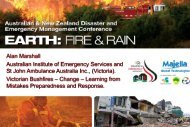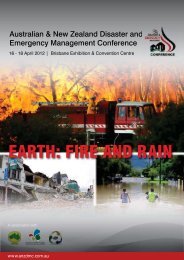Book of Abstracts 2013 - Australian and New Zealand Disaster ...
Book of Abstracts 2013 - Australian and New Zealand Disaster ...
Book of Abstracts 2013 - Australian and New Zealand Disaster ...
You also want an ePaper? Increase the reach of your titles
YUMPU automatically turns print PDFs into web optimized ePapers that Google loves.
Mr Avijit Paul<br />
Queensl<strong>and</strong> University <strong>of</strong> Technology<br />
A framework for identifying named entities from social media discussions in crisis situation<br />
Post hoc analysis <strong>of</strong> social media activities during natural disaster events such as the 2011 Queensl<strong>and</strong> floods <strong>and</strong><br />
Christchurch earthquakes has already been proven to provide rich insights into a range <strong>of</strong> crisis communication <strong>and</strong><br />
information mapping issues. Still, recognizing named entity remains in real time remains a difficult task at the height <strong>of</strong><br />
disaster. It is still highly problematic to differentiate between location mentions that has high degree <strong>of</strong> crisis &<br />
relevance <strong>and</strong> that information which has a low degree <strong>of</strong> crisis& relevance. By looking at velocity in the volume <strong>of</strong> the<br />
archived data from prior disasters, this research presents a framework that can provide further underst<strong>and</strong>ing in<br />
identifying named entities from social media discussion in real time analysis <strong>of</strong> crisis situation.<br />
Ms Kerrie Purcell<br />
Managing Director, Lacuna Resolve Pty Ltd<br />
A Resilient Community is an Informed Community<br />
The start <strong>of</strong> <strong>2013</strong> has seen significant flooding events in Queensl<strong>and</strong> <strong>and</strong> NSW, Queensl<strong>and</strong>’s second major flood crisis<br />
in two years, <strong>and</strong> destructive bushfires across three states. As the world faces increasingly volatile weather patterns,<br />
agencies are being challenged to find improved ways to protect the community from the adverse impacts <strong>of</strong> natural<br />
disasters. Additionally, the increasing complexity <strong>and</strong> interdependencies <strong>of</strong> social, technical, <strong>and</strong> infrastructure systems<br />
are playing a role in increasing community vulnerability to disasters. There is an expectation by the community that<br />
when a disaster does occur, agencies will have appropriately planned <strong>and</strong> prepared for the event, will provide effective<br />
<strong>and</strong> timely warnings, respond appropriately <strong>and</strong> limit the ongoing impacts to the community, environment <strong>and</strong> local<br />
economy. A well-informed community is a more resilient community. Accurate warnings to the public <strong>of</strong> who is likely to<br />
be impacted by a particular event <strong>and</strong> what to expect are critical. <strong>Australian</strong>s are among the world’s most prolific users<br />
<strong>of</strong> the Internet. The increasing use <strong>and</strong> speed <strong>of</strong> this technology (via devices such as smart phones, tablets, <strong>and</strong> by<br />
utilising “Cloud” computing) means <strong>Australian</strong>s now expect easy access to timely accurate information in a crisis.<br />
Geographic Information System (GIS) technology has emerged as the industry’s lifeline. By compiling, analysing <strong>and</strong><br />
mapping data <strong>and</strong> updates from multiple sources into one interactive, easy to use online application, the public is able<br />
to easily access accurate <strong>and</strong> timely information from multiple technology platforms, in multiple locations. This<br />
includes the opportunity to obtain additional information crowdsourced from GPS coded tweets, photos, videos <strong>and</strong><br />
SMS messages from community organisations, schools, government agencies <strong>and</strong> the public. This presentation will<br />
provide emergency managers with an insight into how an organisation-wide approach to GIS technology can transform<br />
the way agencies communicate with the public during a crisis situation.<br />
Mr Bob Roberson<br />
<strong>Disaster</strong> Volunteer Co-Ordinator, Volunteering North Queensl<strong>and</strong><br />
Community Helping Community<br />
Floods, Cyclones, bushfires, tornadoes have again drawn attention to the vulnerability <strong>of</strong> our <strong>Australian</strong> communities.<br />
Most recent in our minds are the Southeast Qld <strong>and</strong> Bundaberg regional floods, <strong>and</strong> the outburst <strong>of</strong> bushfires<br />
throughout the country. This presentation discusses the success <strong>and</strong> leanings from Community engagement during<br />
these disasters. What is outst<strong>and</strong>ing is this countries ability to rally <strong>and</strong> come together to help each other. This<br />
presentation will look at the success <strong>of</strong> the Volunteer <strong>Disaster</strong> Recovery Coordination Program (VCRCG) facilitated by






